Common health problems in rabbits
Although rabbits can suffer from a huge range of illnesses, there are a few which we see very commonly in our clinics, and which you can easily monitor your rabbit for at home. Here we go through those problems, their clinical signs and how they can be treated.
Cystitis
- Cystitis and bladder stones are unfortunately common in rabbits.
- Other species have about 2% calcium in their urine, but rabbits can have urine that is 40-60% calcium.
- This large amount of calcium means they are vunerable to developing crystals or stones of the mineral in the bladder.
- The signs of cystitis include;
- Urinating in unusual places
- Urine staining and scalding around the bottom
- Blood stained urine
- Depression and loss of appetite which is mainly related to the pain of the condition.
- To diagnose this condition, your vet may collect urine samples and take bladder x-rays and blood samples.
- Treatment can include antibiotics, pain relief, fluids, to increase the throughput of urine and flush out any crystals, and sometimes surgery to remove the stones.
- Reducing the amount of calcium in the diet will help prevent this problem.
Dental Problems
- This is probably the most common problem we encounter in rabbits, and can be caused by either poor conformation or poor diet. To learn more about diet in rabbits, click here.
- Rabbits have teeth which grow continually throughout their lives, they get worn down by grinding on each other, and also on the chewy, fibrous food which should form the majority of a rabbits diet.
- Rabbits have 2 main sets of teeth, the incisors, of which there are 2 main pairs on the upper and lower jaws at the front of the mouth, and the molars, which are inside the mouth like our teeth.
- Both these sets of teeth can become overgrown.
- Incisors are commonly misaligned, which means they do not grind on each other and continue to grow. They can become so long they will pierce the rabbits lips or make it impossible for them to eat.
- The molars can develop nasty spikes which pierce the tongue or the inside of the mouth, this makes eating very painful for the rabbit.
- Signs of teeth problems include
- Stopping eating or a reduced appetite
- Weight loss
- Excess salivation - this is because of the pain in the mouth and can cause the rabbits chin to become very wet, and even make the skin sore.
- Overgrown incisors, sometimes the long incisors can be seen poking out of the mouth like tusks, but not always as some will curl into the mouth.
- Once a rabbits teeth have overgrown, the only treatment is to cut them. burr them down, or remove them.
- Overgrown incisors can be clipped or burred quite easily in a conscious rabbit, or if they are a continual problem, your vet may recommend removal under an anaesthetic.
- It is almost impossible to clip or burr molars in a concious rabbit, under most circumstances your vet will advise an anaesthetic.
- Prevention of dental problems is obviously much better than cure, you cannot do anything about poor comformation, but diet plays a huge role in keeping the teeth correctly worn.
- Your rabbits diet should be about 80% hay, this takes a lot of chewing and will ensure the teeth are kept ground down.
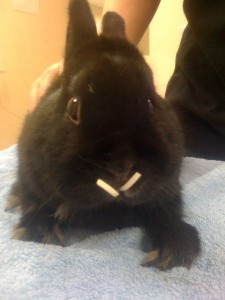
Overgrown incisors, these can be seen growing out of the mouth, but can curl inside the mouth. These can be cut, burred or removed.
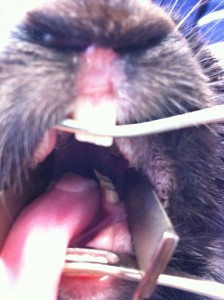
Overgrown molars. If they are not correctly aligned, or the rabbits diet is poor, they form sharp spikes which stick into the mouth and cause a lot of pain. An over-grown molar with a very sharp spike can be seen in the back of the rabbit’s mouth, It would have been digging into the tongue and causing a lot of pain.
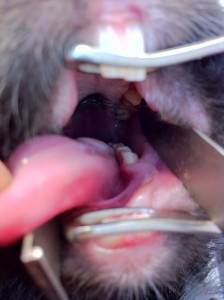
This is the same rabbit with the molar spike rasped down.
Flystrike
- This is a very serious condition that rabbits can develop, especially in the summer months. It has already been discussed in Rabbit parasites, but we will cover it again here as it is so life threatening, common and yet so easily prevented.
- Rabbits produce 2 different kinds of faeces, a hard pellet which is the final product, and a much softer pellet which is designed to be eaten again. (caecotrophs)
- The rabbits diet should consist of large quantities of roughage, and in order to extract all the nutrition from it, they digest it twice.
- If the rabbits do not eat the softer pellets, for example, they may be too fat to reach them, be fed too much other food so they are too full, or they are not cleaned out often enough, they will collect around the bottom in a large mass call a ‘faecolith’.
- This is very attractive to flies, who lay their eggs here, which hatch into maggots. The maggots will eat through the faeces, and then start on the rabbit.
- The maggots can cause huge amounts of damage in a very short space of time, within 12 hours they can go from eggs to nearly fully grown. They will feed on the rabbit, causing the skin to die, and can even gain entry into the abdominal cavity.
- The treatment of flystrike involves removal of the maggots, treating the rabbit for shock, and giving pain relief and antibiotics.
- Rabbits can survive if the problem is caught early enough, but many die despite treatment, or have to be euthanased.
- There are 2 products which can be used to repel the flies. The first is ‘Rearguard’ which is a liquid you ‘paint’ onto the rear end of the rabbit, it repels flies for 12 weeks. The second is ‘Xenex 450’ it is a spot-on product that needs to be used every 2 weeks during the risky summer months to repel flies and prevent eggs from developing.
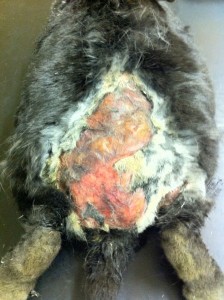
This picture shows the extensive damage fly strike can do to rabbits. This rabbit survived his infestation and was extremely lucky to do so.
Head Tilt (Vestibular Disease)
- Vestibular disease is relatively common in rabbits and can different underlying causes.
- In this disease the rabbits symptoms can include a head tilt, flicking eyes, circling, or can be so bad, the rabbit is unable to stand and keeps falling over to one side.
- These symptoms can come on quite suddenly
- It can be very distressing to see your rabbit with a head tilt, but it is important to remember this is not a painful condition, the balance part of the rabbits brain is not functioning correctly, and they think they are the right way up!
- There are 2 main causes of this problem, they are E.cuniculi, which is a parastic infection or a middle ear infection
- Your vet will probably just treat your pet initially, if they do not respond, they may chose further tests, such as blood tests or xrays.
- Treatment can include wormers to treat E.cuniculi, antibiotics for a middle ear infection, and antiinflammatories.
- Your rabbit may need to be hand fed while they recover their balance, and if the weather is cold, they should be brought inside.
- The prognosis for recovery depends on how bad the original symptoms were, however, many rabbits do improve, although it can take several weeks in some cases, and it is always worth trying treatment.
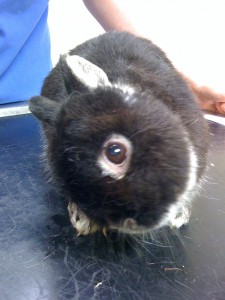
This rabbit is displaying a typical head tilt.
Obesity
- This is a big problem in rabbits, but one which is often missed by owners, after all, rabbits are supposed to be soft and cuddly!
- Obesity is common as many people feed their rabbits large quantities of mixer or pellet diets, which are very high in calories and fats, and there are also lots of treats now available for rabbits.
- There are also now a lot of rabbits kept as house pets, this can mean they don’t get enough exercise.
- Being obese can cause or make the rabbit vunerable to many problems including
- Flystrike - these rabbits can become too fat to clean their bottoms, which in the summer months especially means they are very vunerable to flystike
- Sore feet - especially the back feet and hocks, which bear the brunt of the animals weight. The skin here can become inflamed, infected and painful.
- Sore skin - especially in female rabbits with large dewlaps, they can become so big they are after wet from the rabbits food and water, which can make the skin sore and vunerable to infections.
- Cystitis is also more common in fatter rabbits.
- You should be able to easily feel your rabbits ribs and spine, and they should be easily able to reach to groom their backs and bottoms.
- Dieting a rabbit isn’t easy, but the best way to do it is to cut back dramatically on the hard food, and offer lots of hay and some fresh vegetables. To learn more about the correct feeding in rabbits, click here
- There are also pelleted diets on the market that are formulated to be lower in fat.
Please note this is an advice only website, if you have any specific concerns or queries about your pet, you should contact your vet.